A Long History of Wiping Out Hospitals and Killing Civilians with Air Strikes: Why the Israel-US Genocidal Attack on Gaza Is Far From Unprecedented
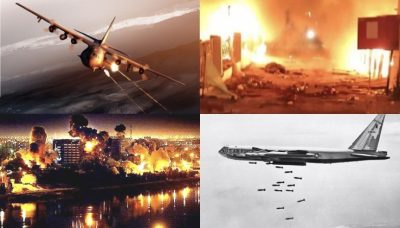
All Global Research articles can be read in 51 languages by activating the Translate Website button below the author’s name.
To receive Global Research’s Daily Newsletter (selected articles), click here.
Click the share button above to email/forward this article to your friends and colleagues. Follow us on Instagram and Twitter and subscribe to our Telegram Channel. Feel free to repost and share widely Global Research articles.
***
Eleven days after the outbreak of full scale hostilities with the Palestinian militant group Hamas, the Israeli Air Force on October 17 bombed the Al Ahli Arab Hospital in the Gaza Strip killing over 500 civilians at a conservative estimate. Overall Palestinian casualties from Israeli strikes over the past 11 days had reached well over 16,000 by that time, although the destruction of the hospital sparked particular international outrage from across the non-Western world with harsh condemnations made from Russia and India to Southeast Asia and Africa.
With the incident gaining particularly high publicity, due largely to the significant international attention that has for decades been concentrated on the Israeli-Palestinian conflict, it has also served to highlight a long history of air strikes hitting and often entirely eradicating hospitals. While these serious war crimes have often gained little attention, a recent history of such attacks over the past 75 years serves to place the latest attack on the Palestinian hospital in context.
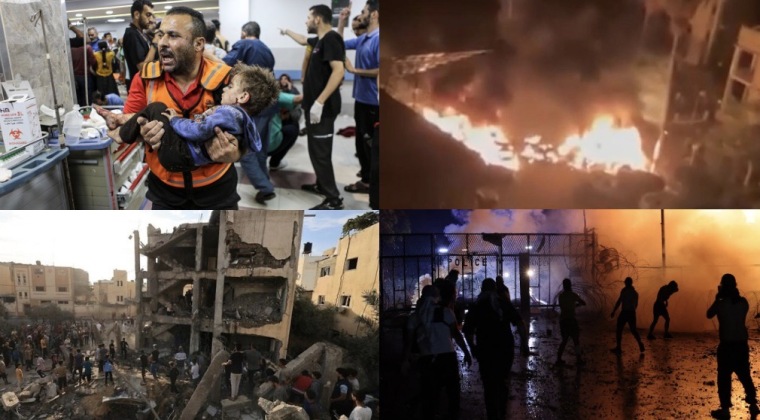
Israeli Strike on Al Ahli Arab Hospital
Second World War
During the Second World War the use of incendiary weapons to carry out firebombing raids by the U.S. Army Air Force allowed it to effectively erase entire portions of cities and their populations, with these indiscriminate attacks resulting in the destruction of multiple hospitals from Dresden in Germany to Tokyo in Japan.
The firebombing of Tokyo on March 9-10, 1945, resulted in the bloodiest night in the history of war with Japanese deaths estimated at well over 100,000. With entire districts of the city and their populations erased effectively overnight, multiple hospitals, schools, temples and other targets were eradicated.
The attack represented among the most serious war crimes in history and caused far more civilian deaths than any other on record, destroying the homes of 372,000 families. General Curtis LeMay who oversaw the attack stated that it killed more than both the later nuclear attacks on Japanese cities combined, with higher estimates for the death toll reaching 500,000.
With smaller firebombing raids targeting the populations of 66 other Japanese cities, mass civilian casualties and the destruction of multiple hospitals with their patients still in them occurred across the country at the hands of the U.S. Army Air Force, culminating in nuclear strikes on the cities of Hiroshima and Nagasaki.
The nuclear attack on Hiroshima destroyed 18 hospitals and 32 first-aid centres, with 90 percent of the city’s medical doctors killed or seriously injured, while in the attack on Nagasaki the city’s chief medical facilities were destroyed including the Nagasaki Medical University and its related hospital, the Urakami branch of Mitsubishi Hospital, Urakami First Hospital.
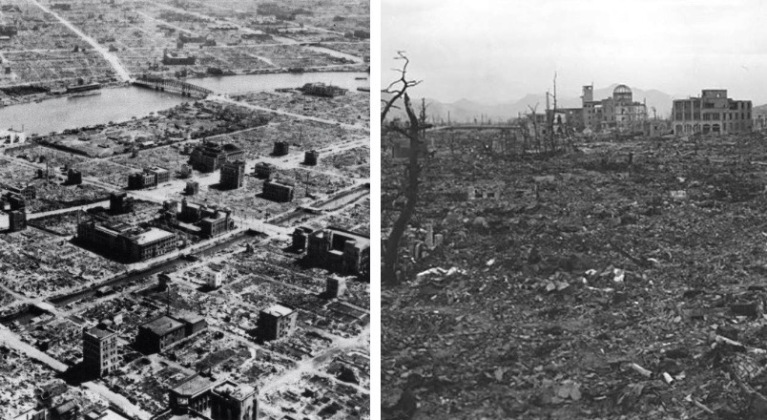
Tokyo (left) and Hiroshima After American Bombings
After the Second World War the continued use of incendiaries for mass bombing raids to target cities from end to end ensured that hospitals would continue to be destroyed in subsequent conflicts. During the Korean War the Supreme Commander of U.S.-led coalition forces General Douglas MacArthur ordered the bombing of “every means of communication, every installation, factory, city and village” in North Korea, stating on a separate occasion regarding the northern half of the country that due to the intensity of Western bombing “this area will be left a desert.”
With Assistant State Secretary Dean Rusk assuring that bombers would attack “everything that moved in North Korea, every brick standing on top of another,” hospitals were far from exempted. The bombing campaign was estimated by the end of the war to have destroyed approximately 1000 hospitals across North Korea as well as killing the majority of the 3–4 million North Koreans estimated to have died in the war.
Air Force General Curtis LeMay later recalled of the bombing of North Korea:
“Over a period of three years or so we killed off – what – twenty percent of the population,” with other estimates being as high as 30 percent.
During the Korean War the initiation of similar firebombing or nuclear attacks against cities across China was widely advocated for by key figures in the American political and military leadership, MacArthur among them, with nuclear weapons forward deployed and their use authorised accordingly. It was primarily the presence of Soviet forces in China, and the demonstrated vulnerability of American bombers to MiG-15 fighters which China was being supplied with, which ensured Chinese cities were not targeted as those in Japan and North Korea had been.
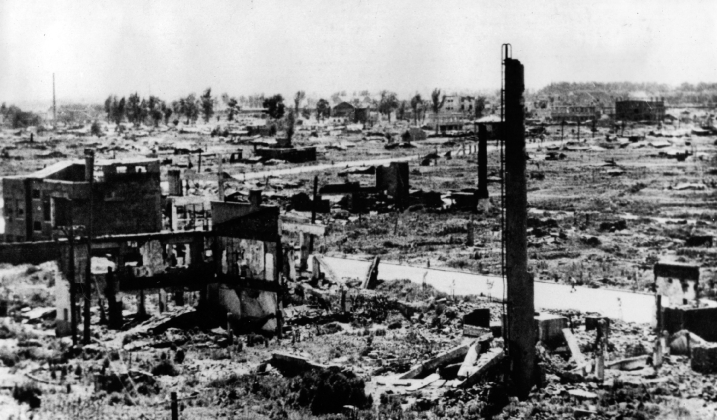
Pyongyang After American Bombings
In the 1960s and 1970s American bombing raids against cities across North Vietnam, Laos and Cambodia caused significant casualties and similarly destroyed hospitals across all three countries, and after the Cold War’s end the Gulf War saw Iraqi hospitals similarly targeted. Where hospitals were not hit directly, the mass targeting of civilian infrastructure including sewage and electricity placed them at serious risk.
An example was revealed in a July 1991 interview by Patrick Tyler from the New York Times with the director of Baghdad’s Saddam Paediatric Hospital, Dr. Qasm Ismail, who recalled that on the first night of the Western air campaign the targeting of civilian infrastructure cut off his hospital’s electricity. As a result:
“mothers grabbed their children out of incubators, took intravenous tubes out of their arms. . . . Others were removed from oxygen tents, and they ran to the basement, where there was no heat. I lost more than 40 prematures in the first 12 hours of bombing.”
The bombing of the Infant Formula Production Plant in the Abu Ghraib suburb of Baghdad on the seventh day of the war, which Washington at the time claimed was a biological weapons facility but which was later disproven, was one of the examples of an attack on Iraq’s ability to provide healthcare which gained greater levels of publicity.
Attacks on pharmaceutical facilities, paired with economic sanctions preventing the import of key medicines, could at times be more devastating than direct strikes on hospitals themselves, with a notable other example that decade being the American missile strike on the Al Shifa pharmaceutical factory in Sudan seven years later in 1998. Washington similarly claimed this was a chemical weapons facility which was again later disproven.
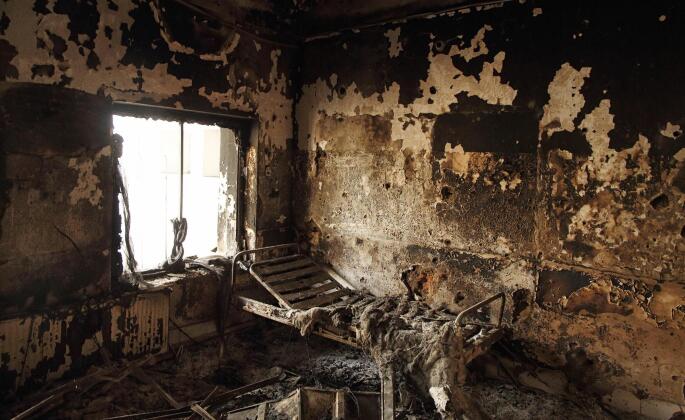
Remains of the Kunduz Trauma Centre in Afghanistan
In 1999 a massive NATO air campaign against Yugoslavia similarly saw hospitals widely targeted. Australian journalist John Pilger referred to civilians being “blown up in crowded passenger trains and buses, in factories, television stations, libraries, old people’s homes, schools and 18 hospitals, many cut to pieces by the RAF’s [British Royal Air Force’s] thousands of ‘unaccounted for’ cluster bombs which fragment into shrapnel.”
A notable example was the Royal Netherlands Air Force’s attacks on a crowded marketplace, a hospital, a university and several shops, in the Serbian city of Nis from May 7–12. When not attacking hospitals directly, the Western air campaign caused food and fuel shortages, loss of access to medicines, destruction of water, sewage and sanitation systems, and breakdowns in healthcare which ensured that hospitals could not function effectively.
Moving into the 21st century air strikes on key medical facilities continued to be launched, with one of the most prominent examples being a strike on the complex housing the International Committee of the Red Cross in Kabul, Afghanistan, with a subsequent second strike on the facility also being launched destroying the food and medical supplies for tens of thousands of Afghan refugees. With NATO forces launching strikes in the country for close to two decades, Afghan medical facilities were far from safe. One of the subsequent attacks which gained most publicity was the October 2015 U.S. Air Force strike on the Kunduz Trauma Centre operated by Médecins Sans Frontières, during which patients were reported to have burned to death in their beds. An AC-130U gunship was used in the attack. Although far from isolated, the incident gained more publicity than other attacks on Afghan medical facilities because the targeted building was operated by a Western organisation. Thus while Israel’s targeting of a Palestinian hospital has been widely condemned and represents a serious war crime, as the world’s leading power and claimed upholder of international norms the conduct of the United States in wartime has for decades made attacks on medical facilities far from abnormal.
*
Note to readers: Please click the share button above. Follow us on Instagram and Twitter and subscribe to our Telegram Channel. Feel free to repost and share widely Global Research articles.
Featured image: AC-130U Gunship, Al Ahli Arab Hospital Attack, B-52 Bombing Vietnam, Bombing of Baghdad; all images in this article are from MWM

